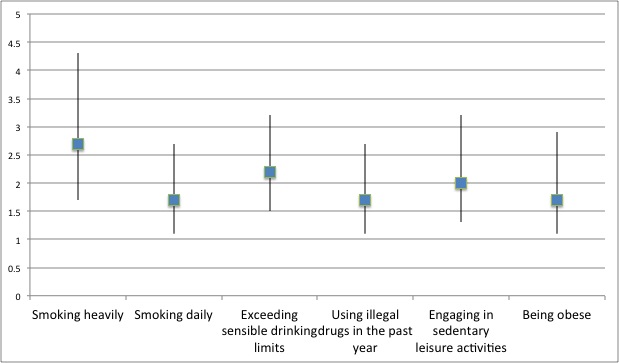The WAGER, Vol. 19(4) – Betting on bad health: Harmful health behaviors among problem gamblers
Problem gambling has many costs. Costs can include personal, financial, and even legal trouble. But, fallout from gambling isn’t just social and emotional. Research shows that problem gambling also is linked with physical health problems (Black et al., 20102). Today The WAGER reviews research that links problem gambling with a number of harmful health behaviors, including lack of physical activity and obesity (Algren et al., 2014).
Methods
- Participants were 19,673 Danish citizens (46% male, 54% female) who completed the Danish Health and Morbidity Survey during 2005 or 2010, which included the two-item lie/bet gambling questionnaire:1
- Participants who responded “Yes, in the past 12 months’’ to either lie/bet question were defined as past-year problem gamblers.
- Researchers used participant responses to health habit questions to define participants in terms of several unhealthy behaviors. Here, we focus on 6 behaviors:
- Smoking heavily (i.e., 15 or more cigarettes per day) as compared to not smoking
- Smoking daily as compared to not smoking
- Exceeding sensible drinking limits (i.e., drinking at least 21 drinks per week for men and 14 drinks per week for women)
- Using illegal drugs (e.g., cannabis, amphetamines, cocaine) in the past year
- Typically engaging in sedentary activities (e.g., reading, TV watching) during leisure time, as compared to engaging in low physical activities (e.g., walking, bicycling) for at least 4 hours a week
- Being obese (i.e., body mass index of at least 30), as compared to being underweight or normal weight
- The researchers used multiple logistic regressions to investigate whether problem gamblers were at higher risk for these unhealthy behaviors.
Results
- Almost 1% of participants were classified as past-year problem gamblers.
- The odds of engaging in unhealthy behaviors were significantly higher among past-year problem gamblers than among non-problem gamblers. As the Figure shows, odds ratios remained statistically significant for four of these behaviors after controlling for several potential risk factors.
- For example, problem gamblers were 2.7 times more likely to be heavy smokers than non-smokers, 2.2 times more likely to exceed sensible drinking limits, and 2 times more likely to engage in sedentary leisure activities.

Figure . Adjusted odds ratios (blue boxes) and 95% confidence intervals (black lines) for health behaviors representing risk associated with being a problem gambler. Odds ratios above 1.0 with confidence intervals that do not include one represent increased risk for the health behavior relative to being a non-problem gambler. Adapted from Algren et al. (2014). All odds ratios are significant at p < 0.05 after controlling for sex, age, survey year, and all other variables included in the Figure. Click image to enlarge.
Limitations
- The lie/bet questionnaire does not distinguish between pathological and problem gambling.
- These correlational results do not provide insight into causal relationships among the variables. For example, it is possible—but not tested here—that excessive gambling itself, as a sedentary leisure activity, contributes to the development of obesity. It is also possible that the personality, environmental, and genetic factors that contribute to problem gambling simultaneously contribute to unhealthy eating and therefore obesity. Longitudinal studies are necessary to test these different pathways.
Conclusion
These results suggest that problem gambling is linked to many unhealthy behaviors. The different unhealthy behaviors could prolong gambling problems. Problem gamblers might need a gambling treatment “cocktail.” A treatment cocktail might include weight management, healthy eating habits, and smoking cessation.
– Heather Gray
What do you think? Please use the comment link below to provide feedback on this article.
References
Algren, M. H., Ekholm, O., Davidsen, M., Larsen, C. V. L., & Juel, K. (2014). Health behavior and body mass index among problem gamblers: Results from a nationwide survey. Journal of Gambling Studies, online first (DOI 10.1007/s10899-013-9437-y).
Black, D. W., Shaw, M., McCormick, B., & Allen, J. (2013). Pathological gambling: Relationship to obesity, self-reported chronic medical conditions, poor lifestyle choices, and impaired quality of life. Comprehensive Psychiatry, 54(2), 97–104.
Johnson, E. E., Hamer, R., Nora, R. M., Tan, B., Eisenstein, N., & Engelhart, C. (1997). The lie/bet questionnaire for screening pathological gamblers. Psychological Reports, 80(1), 83–88.
________________
1 The two questions in the lie/bet questionnaire are “Have you ever lied to people important to you about how much you gambled?’ and “Have you ever felt the need to bet more and more money?’ (Johnson et al.,1997).